Glyph
of Warding
(Abjuration-Alteration)
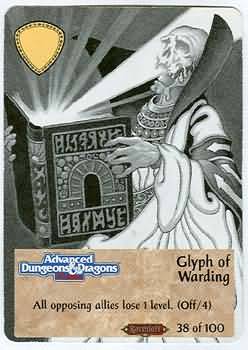
Glyph
of Warding
(Abjuration-Alteration)

|
|
|
|
|
until discharged |
|
|
|
|
|
|
|
|
|
|
|
|
Effect: A glyph of warding is a powerful inscription magically drawn to prevent unauthorized or hostile creatures from passing, entering, or opening.
It can be used to guard a small bridge,
ward an entry,
or as a trap on a chest or box.
When the spell is cast, the cleric weaves
a tracery of faintly glowing lines around the warding sigil. <>
A maximum of a 5’ X 5’ area per level
can be warded. [If 50 square feet or more this requires
powdered diamond!]
When the spell is completed, the glyph
and tracery become invisible,
but any creature touching the protected
AREA without first speaking the name of the glyph the cleric has used to
serve as a ward will
be subject to the magic it stores.
Typical glyphs shock for 2 points of electrical
damage per level of the spell caster,
explode for a like amount of fire damage,
paralyze,
blind,
or even drain a life energy level (if
the cleric is of high enough level to cast this glyph).
CT: For every square
foot of area to be protected,
1 segment of time is required to trace
the warding lines from the glyph,
plus the initial segment during which
the sigil itself is traced.
Effect.Save
Saving throws apply, and will either reduce
effects by one-half or negate them according to the glyph employed
MC: The cleric
must use incense to trace this spell,
and then sprinkle the area with powdered
diamond
(at least 2,000 g.p. worth) if it exceeds 50 square feet.
DMG: If a cleric
is on hand to determine that a glyph of warding is certainly in existence,
an associated magic-user can thereafter
use an erase spell and possibly (50% + 2%/level of the m-u) remove the
glyph.
As to the design and the names of glyphs
of warding, design your own or use an encyclopedia to find interesting
alphabets to use.
You may refer also to THE
WORLD OF GREYHAWK for other runes and glyphs.
For example, here is one such series of
glyphs, named.
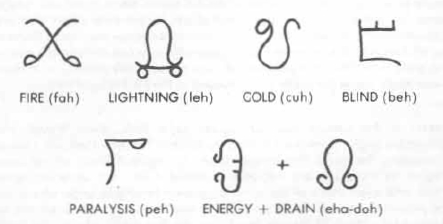
[C4.22 : "24 points of electrical damage"]
As a detect traps
spell will see the form of the glyph,
a cleric might believe he or she knows
the name of the glyph from past experience, and try to - possibly with
success.
"The altar stone and crystal service pieces are
protected by a special glyph of warding
suitable to the place. They cannot be safely
touched unless the symbol of the Air Temple
is worn and the glyph name, whah-duh, is
spoken. Failure in either requirement causes
a whirlwind to suddenly form and spin from
the pit to the altar, inflicting 12 points of
damage to each creature within ten feet of
its path (save vs. spells to take half damage)."
- T1-4, area 210
Death Glyph (A1-4.88)
Terror Glyph (A1-4.88)
Frost Glyph (A1-4.88)
-
Q: What level does
an AD&D cleric
have to be in order to cast
a glyph of
warding that drains a level?
A: Since this glyph
duplicates the effects of
a reversed restoration spell,
the caster
must be at least a 16th-level
cleric.
(145.10)
Q: Can a glyph of
warding be cast
upon a portable object such
as a
sword or sling bullet and
used
offensively?
A: No. A glyph is
a magical ward used to
protect an object. A glyph
can be cast
upon a weapon, but it will
be triggered
only when a creature touches
the weapon,
not when the weapon strikes
a creature.
(153.7)
ADQ: Can a glyph of
warding be put on a
weapon's handle so anyone
touching the
handle would take damage?
ADA: Yes. But note
that the glyph must be
placed upon a surface area,
not a volume,
and that the surface area
must be solid (as
incense is used to trace
the area to be
warded). (Polyhedron #21)
ADQ: How experienced
must a cleric be
to cast a glyph of warding
for paralysis or
energy drain?
ADA: Glyphs
for these and other effects
may be CAST by clerics who
can also CAST
spells with similar effects.
Thus, for a glyph
of energy draining,
the cleric must be 16th
or higher level. Treat paralysis
as if a hold
person effect, thus castable
by anyone who
can cast a glyph
in the 1st place.
(Polyhedron #21)
Q. How experienced
must a priest be to
CAST a glyph of warding
for paralysis
or energy drain?
A. Glyphs for these
and other effects
may be cast by priests who
can also
cast spells with similar
effects. So,
for example, a glyph
of energy draining
can only be cast by a priest
of level
16 or higher (energy drain
is the
reverse of the 7th level
spell restoration).
Taking paralysis
as the equivalent
of a hold
person, means that
this effect is available
to any priest
who can cast a glyph in
the 1st
place.
(Imagine #25)
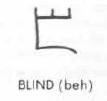
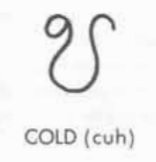

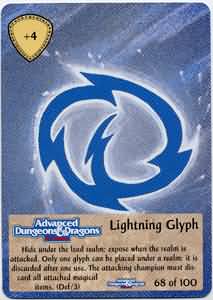
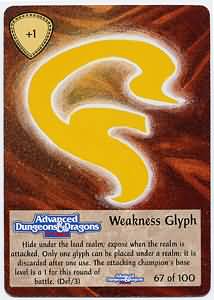
Glyphs
of the Forgotten Realms
The glyphs
of warding found in The
Nathlum reflect its evil
nature. All may
be used only by those of
evil alignments,
and will harm only those
of good
alignments. Anyone of good
alignment
may pass a glyph's location
unharmed
by speaking its name or
by destroying
the glyph. The passage of
neutral or evil
characters will not trigger
any of these
glyphs. They are as follows.
Zuth
can be cast only by a cleric of 6th or higher
level.

It is cast upon a door
or the frame of an opening;
anyone of
good alignment passing through
or
under the portal will suffer
2-12 points
of electrical damage arcing
from side to
side of the frame at many
points around
it, across the opening.
Yammas
can be cast only by a cleric of 8th or higher
level.

When activated,
from 11-18 screaming, chittering
mouths will appear all about
the glyph,
and shoot forth on long
(up to twenty
feet) snakelike necks to
bite at the creature
activating the glyph. The
victim
must save against each manifestation
or
be struck by it, suffering
1-4 points of
damage. The fangs dig in,
much as a
lamprey attacks, and the
mouths drain
1 hit point of blood each
per round
thereafter until they or
the victim are
destroyed. Each can be severed
by
inflicting 7 points of damage
on it (as
long as at least the seventh
point is
caused by an edged weapon),
or by the
victim pulling free of its
grasp. All are
AC7. Any character with
a Strength of
16 or more is allowed to
attempt saving
throws against three of
the mouths
each round--if a particular
save is successful,
the mouth's grip breaks,
it does
not drain blood on that
round, and it
shrinks back into the wall
or hangs lifeless.
This glyph does not vanish
after
one activation; it will
retract its surviving
mouths and wait for the
next victim,
u n t i l a l l t h e m
o u t h s h a v e b e e n
destroyed.
Hlack
can be cast only by a cleric of 9th or higher
level.

This functions as a
magical barrier preventing
those of
good alignment from passing.
This barrier
of force will stand until
the actual
area on which the glyph
was cast is
destroyed, thus breaking
the glyph or
until a knock, erase, or
similar spell is
employed. Anyone of good
alignment
will strike an invisible
wall and suffer 1-
6 points of electrical damage.
Further
contact with the barrier
will cause 1-6
points of electrical damage
per round
(no save).
Curtal
can be cast only by a cleric of 10th or higher level.

Attempts
to pass
this
glyph will cause arms of fire to
burst
from its three pointed ends and
strike
the creature or creatures
attempting
to pass, each arm doing 4-16
points
of damage. Each arm of fire will
strike
a different target if there are
three
or more targets available; otherwise
two
will strike the nearest target
and
one another, or all three will strike
at
a solitary target. (Save for half damage.)
Activation
of this glyph always
alerts
a guardian, sometimes summoning
a
demon
or devil to the spot instantly,
but
more often warning spellcasters
or
beast-keepers to ready their charges.
The
glyph remains until erased, striking
out
with its arms of flame every
time
it is activated. Dispel magic will
cause
one of the arms of fire to shrink
back
and not strike for that activation.
In
each round that creatures stand
before
the glyph but do not speak its
name
(i.e., not having passed it, but
within
15 feet), curtal will activate- so
slow-moving
creatures could be struck
several
times.